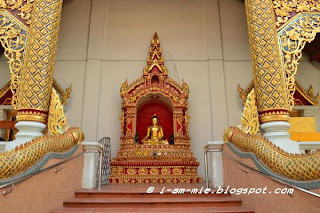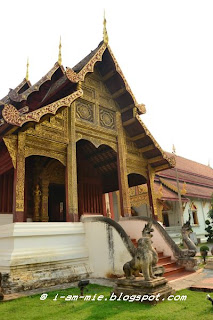Wat Phra Singh is located in the western part of the old city centre of Chiang Mai, which is contained within the city walls and moat. The main entrance, which is guarded by Singhs (lions), is situated at the end of the main street (Rachadamnoen road) of Chiang Mai.
The temple houses an important Buddha statue: the Phra Buddha Sihing which gives the temple its name. The origins of this statue are unknown but, according to legend, it was based on the lion of Shakya, a statue since lost which used to be housed in the Mahabodhi Temple of Bodh Gaya (India). The Phra Buddha Sihing statue is supposed to have been brought, via Ceylon (present day Sri Lanka), to Ligor (present day Nakhon Si Thammarat and from there, via Ayutthaya, to Chiang Mai.
Among the Sights in the complex are:
- Wihan Luang - the original wihan was replaced by the present building in 1925.
- Wihan Lai Kham - this wihan is the main attraction of the complex. It was built in 1345 to house the Phra Buddha Singh statue and it is a prime example of classical Lanna architecture. The murals on the left show the history of Songthong and on the right the history of Suwanna Hongse.
- Ubosot - built in 1806, it contains two entrances: a south entrance for monks and a north entrance for nuns. It is as such a song sangha ubosot ('song' meaning 'two' in Thai). The building houses a mondop with the Phrachaotongtip Buddha statue, a smaller version of the Phra Buddha Sihing and it is therefore also known as Phrasingha noi ('noi' meaning 'small' in Thai). The northern end of the wihan, near the entrance for the nuns, contains a copy of the Emerald Buddha.
- Ho Trai - the temple library is another prime example of classical Lanna architecture and it is one of the most beautiful temple libraries in Thailand. The guards, flanking the stairs, consist of lions emerging from the mouths of a Makara, a mythical water creature. This combination is rarely seen elsewhere.
- The Phrathatluang - each side of the square base of the main chedi of the complex features the front half of an elephant emerging from it. After it was built in 1345, the chedi was enlarged several times.
 |
| the Phrathatluang chedi and Kulai chedi |
- The Kulai chedi - this small square based chedi, built as a pagoda with five tiered roofs by King Mueangkaeo (1495-1525), is connected to Wihan Lai Kham by a short tunnel which is not opened to visitors. When the chedi was restored under King Dharmalanka (1813-1822), a golden box containing ancient relics was found. After the works were completed, the box and its contents were placed once more inside the chedi.

























No comments:
Post a Comment
Please share your thoughts...